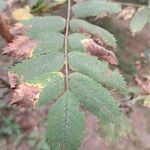Shrubs, 10–50(–80) dm. Stems 1–8; bark gray, sometimes yellowish or reddish purple, or grayish red; winter buds olive brown to red-brown, conic, 8–14 mm, shiny, slightly glutinous, glabrous or sparsely or densely whitish-villous. Leaves pinnately compound; stipules deciduous or persistent, hairs whitish; blade paler abaxially, shiny, green to dark green adaxially, leaflets 7–13(–15), opposite or subopposite, lanceolate, oblong, narrowly ovate, oblanceolate, or obovate, (3–)4–6.5(–8.7) × 1.5–2.7 cm, l/w ratio 2.1–4.4, margins finely serrate, apex obtuse, acute, or acuminate, surfaces glabrous, leaf and leaflet axils hairy, hairs whitish. Panicles 40–200+-flowered, flat-topped to rounded, 5–15 cm diam.; peduncles sparsely to densely whitish-villous. Pedicels sparsely to densely whitish-villous (in flower and fruit). Flowers 11–13 mm diam.; hypanthium nearly glabrous or densely villous, hypanthium plus sepals 3–4 mm; sepals 0.8–2.3 mm, margins lightly to densely whitish-villous, glands absent or sparse and usually inconspicuous; petals white, ovate, 4–6 mm; stamens (14–)20; carpels distinct, apex conic, styles 3 or 4, 2–2.5 mm. Infructescences whitish-villous, rarely glabrous with age. Pomes bright orange to reddish orange, globose, subglobose, broadly obovoid, or broadly elliptic, 8–12.1 × 7.5–12.8 mm, shiny, sometimes lightly glaucous; sepals inconspicuous, incurved. Seeds brown, narrowly ovoid, 3.8–5.4 × 1.7–2.8 mm, slightly asymmetric, slightly flattened. 2n = 34, 68.
More
A shrub. It grows 1-4 m high. The leaves are alternate and compound. There are 11-13 sword shaped leaflets. There are teeth along the edge. The flowers are white and small. They are 5-10 mm across. They are urn shaped. The occur as a group in rounded clusters. These are 8-16 cm across. The fruit is a small orange-red berry.
Mountain slopes, open forests, forest edges, riparian zones, lakeshores; at elevations up to 3,300 metres.






